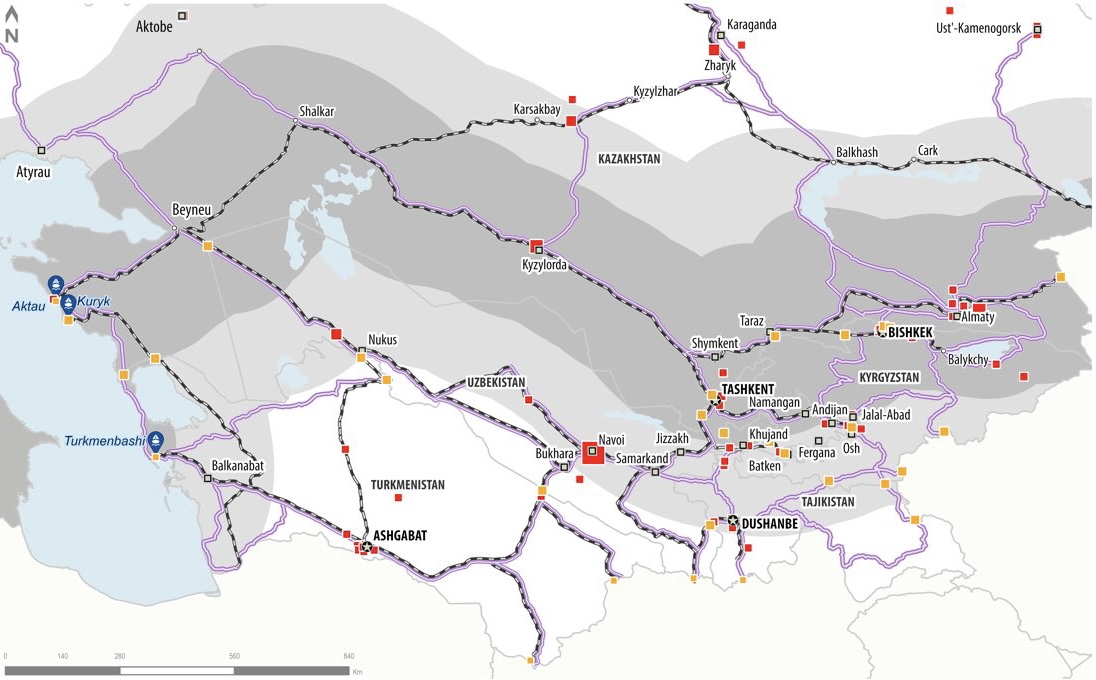ASTANA – The Central Trans-Caspian Network, traversing through southern Kazakhstan, is the most sustainable option for forging the links between Central Asia and Europe, increasing container volume from 18,000 twenty-foot equivalent units (TEU) in 2022 to 130,000 TEUs by 2040, according to the European Union (EU) and the European Bank for Reconstruction and Development (EBRD) Study on Sustainable Transport Connections between Europe and Central Asia.

The Central Trans-Caspian Network, traversing through southern Kazakhstan. Photo credit: the EBRD.
The study conducted by the EBRD and funded by the EU aimed to identify the most sustainable transport network connecting the five Central Asian countries, Kazakhstan, Kyrgyz Republic, Tajikistan, Turkmenistan and Uzbekistan, as well as links with the EU’s Trans-European Transport Network (TEN-T), which covers the 27 EU member states. It also outlines key actions for the development of the network.
The report comes at a time when the Eurasian Northern Corridor, which served as the main route linking northeast Asia with Europe, suffers from the economic fallout of the Russian military operation in Ukraine.
The Central Trans-Caspian Network was considered among three currently existing corridors spanning the territory of all five Central Asian countries.
It embodies the EU vision of a comprehensive, sustainable, rules-based and people-centered approach to connectivity and contributes to implementing the EU Strategy on Central Asia and the EU’s Global Gateway Strategy.
The study proposes seven soft connectivity measures and 32 hard infrastructure investment needs across all five Central Asian countries. The findings of the study are country-specific and address concrete points of intervention.
The measures combine policy instruments, such as the digitalization of transport documents, improving interoperability, enhancement of the public-private partnership (PPP) environment, trade facilitation, market liberalization, improvements to tariff-setting mechanisms and increasing funding allocation for asset maintenance.
Country-specific priority investment needs for Kazakhstan include Almaty-Khorgos and Aktau-Beyneu railway double-tracking, expansion of several terminals and railway stations, and Aktau port capacity expansion, among other projects.
Total investment needs for the region are estimated to be around 18.5 billion euros (US$20 billion).
The study estimates that transit container volume can increase to 865,000 TEUs by 2040 if those investment projects and soft connectivity measures to achieve a free-flow transit time of 13 days are implemented.
“Assuming containerized trade also increases in Central Asia, in addition to the aforementioned improvements, the network can also observe regional container volumes of 470,000 TEUs by 2040. Hence, identified and prioritized key actions would not only support cross-continental transportation but also regional trade and economic growth in Central Asia,” reads the report.
According to the report, the development of the Central Trans-Caspian Network would yield significant benefits for the region.
One is that it would allow stronger regional coordination and increased connectivity between economic centers while improving border-crossing practices, lowering transaction costs and increasing the user-friendliness of procedures.
The network development would also enhance long-term planning, improving project prioritization and implementation.
The cost reduction factors in environmental damage from pollution driven by greenhouse gas emissions are also considered.
To understand the processes that would ease the flow of cargo along the networks, the EBRD team consulted a large set of stakeholders, from government authorities in each Central Asian country to associations and the private sector in Central Asia, Europe, the Caucasus, and Türkiye, EU member states and EU delegations in the region, international financial institutions, among other relevant international organizations.
Findings from the EBRD study could provide international financial institutions and the private sector looking to invest in transport and logistics with potential investment opportunities.
The final report on the study will be published and circulated by the end of June.

